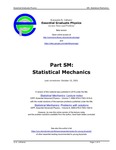Part SM: Statistical Mechanics
Editorial: Universidad de Stony Brook
Licencia: Creative Commons (by-nc-sa)
Autor(es): Konstantin K. Likharev
1.1. Introduction: Statistical physics and thermodynamics
Statistical physics (alternatively called “statistical mechanics”) and thermodynamics are two
different but related approaches to the same goal: an approximate description of the “internal”2
properties of large physical systems, notably those consisting of N >> 1 identical particles – or other
components. The traditional example of such a system is a human-scale portion of gas, with the number
N of atoms/molecules3 of the order of the Avogadro number NA ~ 1023 (see Sec. 4 below).
The motivation for the statistical approach to such systems is straightforward: even if the laws
governing the dynamics of each particle and their interactions were exactly known, and we had infinite
computing resources at our disposal, calculating the exact evolution of the system in time would be
impossible, at least because it is completely impracticable to measure the exact initial state of each
component – in the classical case, the initial position and velocity of each particle. The situation is
further exacerbated by the phenomena of chaos and turbulence,4 and the quantum-mechanical
uncertainty, which do not allow the exact calculation of final positions and velocities of the component
particles even if their initial state is known with the best possible precision. As a result, in most
situations, only statistical predictions about the behavior of such systems may be made, with the
probability theory becoming a major tool of the mathematical arsenal.
However, the statistical approach is not as bad as it may look. Indeed, it is almost self-evident
that any measurable macroscopic variable characterizing a stationary system of N >> 1 particles as a
whole (think, e.g., about the stationary pressure P of the gas contained in a fixed volume V) is almost
constant in time. Indeed, as we will see below, besides certain exotic exceptions, the relative magnitude
of fluctuations – either in time, or among many macroscopically similar systems – of such a variable is
of the order of 1/N1/2, and for N ~ NA is extremely small. As a result, the average values of appropriate
macroscopic variables may characterize the state of the system quite well – satisfactory for nearly all
practical purposes. The calculation of relations between such average values is the only task of
thermodynamics and the main task of statistical physics. (Fluctuations may be important, but due to
their smallness, in most cases their analysis may be based on perturbative approaches – see Chapter 5.)
1 For remedial reading, I can recommend, for example (in the alphabetical order): C. Kittel and H. Kroemer,
Thermal Physics, 2nd ed., W. H. Freeman (1980); F. Reif, Fundamentals of Statistical and Thermal Physics,
Waveland (2008); D. V. Schroeder, Introduction to Thermal Physics, Addison Wesley (1999).
2 Here “internal” is an (admittedly loose) term meaning all the physics unrelated to the motion of the system as a
whole. The most important example of internal dynamics is the thermal motion of atoms and molecules.
3 This is perhaps my best chance for a reverent mention of Democritus (circa 460-370 BC) – the Ancient Greek
genius who was apparently the first one to conjecture the atomic structure of matter.
4 See, e.g., CM Chapters 8 and 9.
Compartir:
Una vez que el usuario haya visto al menos un documento, este fragmento será visible.


